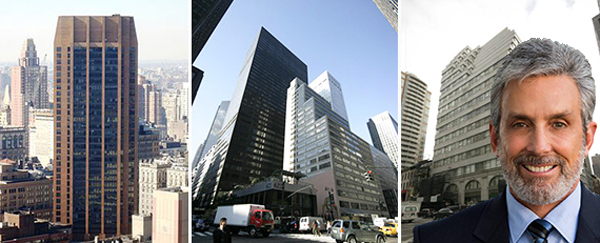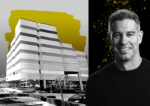Trending
Charles Cohen on why he has no interest in building ground-up in New York
Manhattan office landlord has shifted his focus to Los Angeles

Real estate developer Charles Cohen is the CEO of Cohen Brothers Realty Corporation, a company founded by his father Sherman Cohen. He took the reins in the late 1980s. The firm’s portfolio spans 12 million square feet across New York, Texas, South Florida and Southern California. In New York, this includes trophy office buildings such as 3 Park Avenue, 750 Lexington Avenue and 622 Third Avenue as well as design centers like the D&D Building at 979 Third Avenue.
Cohen, a producer of “Frozen River” and the documentary “Hitchcock/Truffaut,” also recently purchased the Quad Cinema at 34 West 13th Street in the Village in 2014 and has plans to reopen it next year as a high-end, repertory theater. In Southern California, Cohen also owns the Pacific Design Center in West Hollywood, a 1.2 million-square-foot hub for interior design showrooms and offices.
He sat down with The Real Deal to talk about the office market, his plans for the Quad and why he’s not interested in developing in New York.
Why have you stuck to the commercial real estate space?
I’m not a one-family homebuilder. I’m not a seller of property. I’m an empire builder. I’m not looking for the last dollar or a quick profit.
What gives you an edge in that business?
After law school, I went to work at Chemical Bank, doing loan workouts. That was an eye-opening, transformative experience for a young person, dealing with problem loans. I believe if you can fix a problem, you can avoid them in your own business. I’ve used that experience to avoid pitfalls on things I’ve undertaken.
Why have you gravitated towards trade centers?
My father always said trade buildings were very safe and secure, conservative investments. Once you have a couple of the industry’s anchor tenants in there, no one wants to leave. People are lazy. They don’t want to be running all over the place when they can do it all under one roof. You stay in one place, you get something to eat, you make a day of it.
What kind of shape is the office market in?
It’s going through a transformation right now. You have some rezonings that will transform development in the Midtown corridor. That’s going in a good positive direction and will allow landmarks to transfer air rights so development can continue. It will keep Midtown relevant. The tech world has been great for demand in commercial real estate. Now, we’re going through an adjustment in the hedge fund industry, where’s there’s a lot of sublease space that needs to be absorbed. The free market will always find its level of equilibrium through the repurposing of buildings. Never underestimate the creativity of a smart real estate developer.
Do you think Midtown has become less relevant?
We’re going through a short-lived issue of perception, where areas that would never have been considered fashionable take on a character because they’ve been redeveloped. There’s nothing wrong with redeveloping neighborhoods and having them become desirable but let’s not lose track of what we already have.
Do you have vacancies at buildings in your portfolio?
Yes, and we’re working to have it filled. We have a few floors at 750 Lexington Avenue and at 135 East 57th Street. We’re very careful about who we make deals with and very in tune with updating and reinvesting in our buildings. I just redid 475 Park Avenue South with a totally new Cesar Pelli curtain wall and a new lobby. I’m now going to start on The Plaza. At 3 Park Avenue, we’re transforming it from the third floor down. It’s a constant program of reinvestment and always upping our game to stay attractive.
Is that more a necessity as the market becomes more competitive?
We operate on our own timeframe. You can’t react fast enough to any market change that would be considered precipitous. Our plans is always to try to move ahead of the market.
What attracted you to the Quad Cinema?
My other passion besides real estate is film and film history. The two businesses, real estate and film, aren’t so different. Development is development, whether you’re building real property or intellectual property. You create assets, you restore them, remarket them, create income. What’s interesting about the film side is that there are so many different sources of income — the theatrical side, the streaming, the cable, the broadcast, the DVDs.
What’s the plan there?
It’s a total gut renovation, from soup to nuts. It was not a project we would feel comfortable maintaining the way it was. It will open this spring. It’s going to be a beautifully designed venue. One of the four screens will be dedicated to repertory films.
What’s your stance on the retail market?
My philosophy on retail is that I don’t necessarily want the fastest, highest-paying tenant. I want something that’s going to complement the office buildings. What do you see on the ground floor when you walk into a building? I’m very conscious about the image. Retail food does not work for me. There are odors, vermin, things that don’t fit into the upper-class character of the building.
You famously let the retail at 135 East 57th Street sit vacant for year, rejecting several offers, before signing a deal with Saks OFF 5th …
We had for a number of years the challenge of retenanting a 50,000 square foot space formerly occupied by Daffy’s. It wasn’t like I set out to wait forever to rent it, but it was the right thing to do. Saks is doing fantastically well for them.
Borders moved out of the retail space you own at 465 Park. Are you looking to retenant it?
There is not a large reservoir of 40,000- or 50,000-square-foot tenants. There’s always been a reluctance of high-end retailers to go east of Park Avenue. It’s challenging. Retail on Park Avenue has never been that strong — mostly institutional. I’m going to lease several units on the corner as retail and I am using the mid-block entrance to develop on the second, third and fourth floors a series of medical offices. There’s a demand for it. It’s good to have a mix in your portfolio of different kinds of uses.
Why did you want to expand into L.A.?
I like diversifying geographically and warm weather. New York’s a tough place to do business and I have no interest in buying sites in New York. The costs are too high and the upside is too small. The properties that I own were bought at a basis that today looks inexpensive. I brought everything that I had learned here out there. I think I was ahead of the curve.
How much office space do you have left at the Pacific Design Center in Hollywood?
I have about 150,000 square feet of space left, out of 400,000 square feet. We expect to be leased up by the end of the year.
Are you looking to do more in L.A.?
I’m working on two more things right now, but I can’t talk about them yet.
It’s a tough business.
You gotta hand it to real estate developer who work in New York City. People always characterize New York landlords are tough guys, well it’s a tough business. You have to have a thick skin, resilience, wherewithal and creativity.
The Wall Street Journal wrote a story a couple of years ago about your lack of a succession plan. Have any of your kids gotten involved with the business since then?
No, none of them are. I’m 64 years old and I’m not going anywhere.
It seems a bit premature to be talking about succession.
It’s foolish, but people ask foolish questions.




